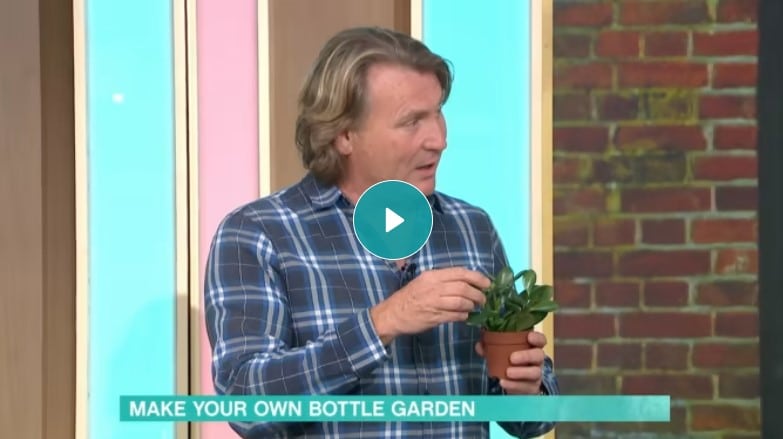Updated 10/02/25
Incorporate a contemporary design with soothing, natural elements that are a stunning stand-out feature in any room. Houseplants are a great investment and not only look amazing. But they also bring nature indoors and some even purify the air in our homes and increase oxygen levels.
Watch this video where I show you how to make your own terrarium:
Although terrariums may look modern, they were invented in Victorian times. They were used to protect plants from London’s polluted atmosphere or to ship them from tropical climates as far away as South America and Australia.
Types of terrarium
Firstly, there are two types of terrarium: open and closed. Both are made from a selection of compatible plants (plants that need the same growing conditions). And they live in an enclosed, or partially enclosed, clear container (which can be plastic, but is usually glass).
Whether you choose an open or closed type will be determined by the plants you want to grow. For succulents and cacti, you will want an open container to allow you to control the moisture.

On the other hand, tropical plants like ferns, orchids, and mosses, you will want a closed container to trap the moisture and heat.
A closed terrarium can actually be a self-contained ecosystem. Sunlight evaporates the water within during the day, and at night the water cools and runs back to the bottom. Just like the Earth’s water cycle.
Get creative

You can of course go and buy some gorgeous terrariums. However, one of the greatest things about these beauties is that you can make your own out of almost any old glass container. Also, they can be closed or open topped, and you can use anything from a little old jam jar to a repurposed fishbowl, or even an old coffee pot!
Have a rummage in your local charity shops to see if there is any interesting glassware available for low prices.
Let there be layers
First, the trick to creating a good terrarium is all in the layers. At the bottom you will want a layer of small stones or gravel. This creates drainage to make sure your plants aren’t sitting in stagnant water.
If you can get hold of some, a layer of crushed charcoal will keep your soil fresh (especially if it is a closed terrarium). Next, add a layer of sand and top it off with a good layer of soil.


Altogether, this should fill around a third of the height of your terrarium. Be sure to pay close attention to how the sides look, as they will be on display!
Fill it up
Now it’s time to get your terrarium plants in. Don’t get carried away – three is probably enough.
You can do as many as you like, but just make sure it’s not too crowded, and that the foliage isn’t touching the glass. Start with the larger plants and then add the smaller ones. You may need some long tweezers or something like chopsticks can work great too.
Most importantly, make sure your plants are compatible, and their needs are the same – ferns and cacti don’t mix!

For something really interesting, try some air plants (epiphytes); many of them look almost otherworldly and they absorb moisture from the air.
Terrariums work best when they look like a miniature world of their own. Adding mosses, bits of wood, perhaps a couple of decorative stones and such will make it look like its own little landscape. Some people even add little figures for a real novel effect!
Take care

Look after your terrarium by not placing it in direct sunlight or near a radiator because the plants will burn up. You want a bright position with plenty of indirect light.
For closed containers, the moisture should recycle but just keep an eye on it so that it doesn’t need topping up.
Open containers should be treated like any other houseplant, but it’s a good idea to spray water rather than pouring because it gives you more control.
It’s ideal to remove any dead, dying or diseased foliage and prune the plants if they do get too large, but don’t fertilise the plant and ensure the plants aren’t touching the glass.
With these tips you will have a stylish glass container that will be an instant talking point in your home where they can sit on the side like a normal plant pot, or you could alternatively create a hanging terrarium using some twine.


Leave A Comment